| |
 |
Stillwater |
Oklahoma |
USA |
Vertical Dial |
Dial 945 |
| This modern etched glass sundial faces nearly due south (declining only 48' East of South) with hour lines from 6am to 6pm marked in Roman numerals. The dial is a large 5 x 9 feet and held extended from the windows behind. The gnomon is a simple brass rod without nodus. No solstice lines or other embellishments mark the clean look of the dial face, making it easier to read from street level 3 stories below. The dial can also be read from inside the building. |
| |
| |
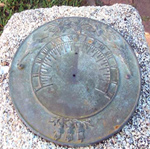 |
St. Augustine |
Florida |
USA |
Horizontal Dial |
Dial 944 |
| The bronze dial is about 18 inches in diameter with hour numbers in Roman numerals from 5am to 7pm. Decorated with hummingbirds on both the east and west sides and flowers both top and bottom. The gnomon is missing. |
| |
| |
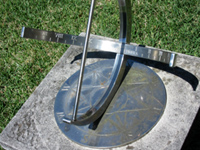 |
St. Augustine |
Florida |
USA |
Equatorial Dial |
Dial 943 |
| A stainless steel about 12-inches in diameter with an equatorial band from 6am to 6pm. The equatorial band is about 1 1/2 inches wide while the meridian arc is about one inch wide. The gnomon is a stainless steel rod about 1/4 inch in diameter. The metal support has a large compass rose, with points to the four major and minor cardinal points. The dial sits upon a classic Charles Dickens formed pedestal with square base and top. |
| |
| |
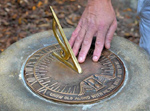 |
Savannah |
Georgia |
USA |
Horizontal Dial |
Dial 942 |
| An 8-inch diameter bronze dial, with the traditional hourglass and wings says "Grow old along with me, the Best is yet to Be", The chapter ring has Roman numerals with hour marks delineated every 15 minutes. The dial sits upon a concrete pillar inscribed to Louis Burke Toomer. |
| |
| |
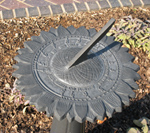 |
St. Louis |
Missouri |
USA |
Horizontal Dial |
Dial 941 |
| The dial has a horizontal plate about 10.5 inches in diameter made of bronze with a green-grey patina. The plate is sculpted as a sunflower. Hour lines are inscribed every 15 minutes and hours indicated in Arabic numbers. |
| |
| |
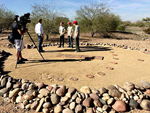 |
Phoenix |
Arizona |
USA |
Analemmatic Dial |
Dial 940 |
| On a trail of desert scrub is a cleared circular area, defined by a low pile of river stones as the border. Within is a titled analemmatic sundial about 30 feet across. The center walkway is made of sized adobe-red concrete tiles for each month. The abbreviation of each month is set into the tile. The matching hours on their elliptical arc are marked with small adobe-red concrete circles. |
| |
| |
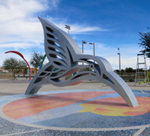 |
Peoria |
Arizona |
USA |
Horizontal Dial |
Dial 939 |
| This wonderful sculpture of a hummingbird serves as the gnomon for an 18 foot diameter horizontal sundial. The sundial sculpture was inspired by the beauty of the hummingbird with many species of them living and thriving in Arizona. The gnomon stands 7-feet tall with intricate aluminum frets welded together to give both depth and warmth to the hummingbird. Surrounding the gnomon are 150,000 Vetriluxe one-inch square glass mosaic tiles in bright colors depicting a flower where the bird sucks nectar. Inlaid into the tile work are Arabic hour numbers from 6am to 6pm as well as the cardinal points. |
| |
| |
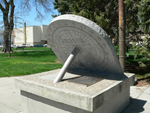 |
Columbus |
Nebraska |
USA |
Equatorial Dial |
Dial 938 |
| This monumental equatorial dial is in the style of an Erickson dial with 6-inch polar gnomon and granite dial plate about 10-inches thick and 4 feet in diameter. Summer hours (between the spring equinox and continuing until the fall equinox) are seen on the north face of the dial while winter hours (fall equinox and continuing until the spring equinox) are seen on the south face of the dial. Hours are delineated into quarter hours with hours marked in Arabic numbers. The chapter ring of hours divide the entire 24 hours of the day for artistic purposes. The dial sits on a square 5-foot concrete dais that holds a time capsule from the dial's dedication in 1986 that is to be opened 50 years hence in 2036. A bronze plaque on the dais explains the dial and the time capsule. |
| |
| |
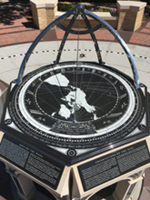 |
Fort Worth |
Texas |
USA |
Horizontal Dial |
Dial 937 |
| This elegant horizontal dial is more than just a horizontal sundial. The designer, William Andrewes refers to this instrument as a "longitude dial". First designed by Franz Ritter in 1607, the dial plate contained a gnomonic map projection. The TCU dial has a map projection centered on Fort Worth. The dial is about 48 inches in diameter, made of black granite with excellent inset white marble for dial lines and a chapter ring delineated to the minute. An outer chapter ring gives the months of the year and corresponding minute correction of the Equation of Time. The gnomon is a thin rod with nodus to cast shadows on the map's tropic of Cancer, equator, and tropic of Capricorn. Other day lines record significant dates for Texas Christian University. |
| |
| |
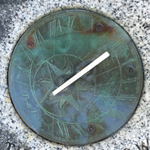 |
Saanichton |
British Columbia |
Canada |
Horizontal Dial |
Dial 936 |
| A simple horizontal bronze sundial about 9 inches in diameter. A sun occupies the interior of the dial with hour lines extending to a chapter ring with Roman numerals marking the hours. Each hour is divided into eight parts along the outer edge of the dial. The dial sits on a square plinth with corresponding square stepped base. |
| |
| |
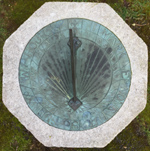 |
Saanich |
British Columbia |
Canada |
Horizontal Dial |
Dial 935 |
| The dial is simply but pleasingly decorated. The gnomon is plain. The pedestal is carved from stone taken from ruins of the Basilica of Ste. Anne de Beaupre in Quebec. The Quebec connection is indicated by the use of a Fleur De Lys on the dial face, and Napier's Scottish heritage is referenced by thistle motifs on brass accoutrements fitted to the pedestal. |
| |
| |
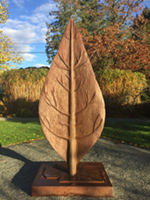 |
Surrey |
British Columbia |
Canada |
Sculpture/Artwork |
Dial 934 |
| The sculpture, titled "Gnomon", is a metal clematis leaf about 9ft tall and 3ft 6in wide at its widest point. It varies from about 1 in at the edge to about 4 in in the middle. The base is marked with cardinal directions and a present map of the neighborhood. There are a series of twelve 9 inch disks arranged around the sculpture set at a radius of 9 ft. The disks are positioned every 30 degrees around the circle, and at the north point, is an additional disk for "12 PST". All components of the sculpture are case iron, set into a graveled area. According to accompanying information,"Gnomon, featured in Fleetwood Park’s perennial garden, is inspired by the notion of a sundial marking time. A gnomon is the central part of a sundial that casts a shadow that marks the passage of time. This artwork tells the story of the passage of time in the growth, change, and appearance of Fleetwood’s historic community landmarks. |
| |
| |
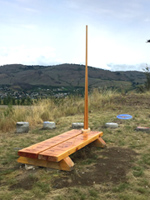 |
Vernon |
British Columbia |
Canada |
Analemmatic Dial |
Dial 933 |
| This is a standard outdoor analemmatic dial located on a hillside allowing all-day illumination and providing good views of Vernon and the surrounding area. The layout was designed by James Kanester. Rather than acting as a "Human Sundial" this analemmatic uses a movable vertical pole that sits in a slot in the declination scale. A central figure-8 analemma curve provides an indication by date where to place the gnomon in the slotted meridian grove. The declination scale, designed and constructed by Joel Wrinch, is wooden with engraved lettering and analemma. The dial's hour marks are concrete posts, topped by glass mosaics made by local artist Connie Vetter-Johnson. Only whole hours are marked. Dial furniture includes a larger glass mosaic image of a hawk. The dial's major axis is about 22 feet, the declination scale is about 6 feet long, the hour markers are 12 inches in diameter. The hawk mosaic is about 18 inches in diameter. |
| |
| |
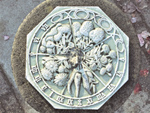 |
Vancouver |
British Columbia |
Canada |
Horizontal Dial |
Dial 932 |
| This was once a very beautiful sundial sitting on a short concrete pedestal. Now it has a missing gnomon and the dial color is uniformly aquamarine except where the coating has been rubbed away to reveal a white substrate. Tapping the dial face makes a dull sound suggesting the dial is not metal and may be hollow. A possible explanation is that the dial could be made of some kind of cast resin or fiberglass and was then spray-painted. The dial face itself is elegantly sculpted into five sectors, showing clusters of flowers, berries and fruits, creating a pronounced 3D effect. Because of this, the hour lines are reduced to short ticks at the edge of the dial face. The dial shows solar hours, marked off using Roman numerals. |
| |
| |
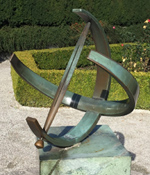 |
Vancouver |
British Columbia |
Canada |
Equatorial Dial |
Dial 931 |
| A simple but elegant and well-executed bronze equatorial dial by renowned local sculptor Gerhard Class. It is about 24-inches in diameter and is mounted on a 16 x 16 x 36-inch plinth of nephrite jade, damaged at one corner. The gnomon has a central slit and can be rotated about the polar axis to create a narrow beam of light for precise reading of the sun's position. The dial shows local solar time plus one hour, corresponding to Daylight Saving Time. The dial's construction is technically perfect but, sadly, the dial appears to be misaligned with the gnomon axis pointing 7 deg west of north. |
| |
| |
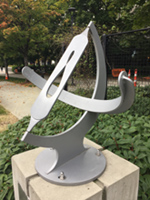 |
Burnaby |
British Columbia |
Canada |
Equatorial Dial |
Dial 930 |
| This substantial and durable 30 inch anodized aluminium equatorial dial is mounted on a concrete plinth with a brass plaque showing the Equation of Time and usage instructions. The gnomon consists of two parallel plates each with a figure-8 analemma cut out. When the figure-8 apertures are rotated toward the sun, the dial illumination is corrected for the equation of time by reading the correct edge of the analemma for the date. If it the gnomon is turned sideways to the sun, the gap between the plates form a slit that produces a narrow beam for reading solar time adjusted to the longitude of the Pacific time zone. The hour scale is marked out at 5 minute intervals. Hours are labeled for Standard Time and for Daylight Saving Time. |
| |
| |
 |
Dawson Creek |
British Columbia |
Canada |
Analemmatic Dial |
Dial 929 |
| An analemmatic dial 23 feet 7 inches wide consisting of a simple concrete slab with black painted marking. Shows solar time plus one hour (akin to Daylight Saving Time). Dial is in memory of a local artist and community activist Edna McPhail (1923 - 2008) who championed the development of the Peace Park in which the dial is located. |
| |
| |
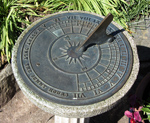 |
Brentwood Bay |
British Columbia |
Canada |
Horizontal Dial |
Dial 928 |
| This is simple horizontal sundial with the standard cast bronze dial plate, 12 inches in diameter. The sundial shows local solar time with Roman numerals from V to VII with noon marked as XII. The dial is delineated with marks for the half and quarter hours. The hour lines and gnomon angle are correct for the latitude. The gnomon root is in the center of the circular casting. Radiating out from the center is a compass rose showing the cardinal directions. |
| |
| |
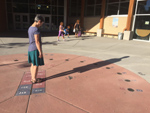 |
Vancouver |
British Columbia |
Canada |
Analemmatic Dial |
Dial 927 |
| The analemmatic sundial is laid within a 15-foot circle of light red concrete, set in the middle of a large grey concrete concourse on the south side of the school. Hour points are marked by 4-inch bronze disks embedded in the concrete; the declination scale is made of embedded tiles. The scale is red in part and blue in part, denoting the summer and winter periods. Correspondingly, each hour point hour is labeled twice; red for Daylight Saving Time and in blue for Standard Time. The dial incorporates a longitude correction for the time zone, and features Sunrise & Sunset Markers ("Bailey Points"). All labels were hand-painted by students - a deliberate measure intended to require occasional repainting and hence continued student engagement and involvement with the dial over the years. |
| |
| |
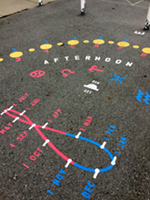 |
District of North Vancouver |
British Columbia |
Canad |
Analemmatic Dial |
Dial 926 |
| This rather strange split analemmatic dial shows civil time. It has separate morning and afternoon dials with time marks for standard (blue) and daylight saving (red)time. Instead of the usual linear declination of dates made into a walkway on the meridian line, the split analemmatic dial has two analemmas, one for morning and one for afternoon with the yearly dates for standing on the analemma to correct solar time to civil time. As it turns out, the analemmas that are drawn are not "classic" analemmas but special curves where the position on each date is estimated as an average position to correct for all morning or afternoon hours. The only other such dial is at Longwood Gardens in PA. (NASS #328) |
| |
| |
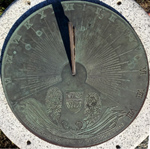 |
Vancouver |
British Columbia |
Canada |
Horizontal Dial |
Dial 925 |
| A delightful dial in a delightful setting, well worth the modest admission fee. It is an 18 inch patinated bronze disk mounted on an elegant white granite pedestal, with the hours adjusted to the time zone. The face is a finely crafted bas relief delineated in quarter hours, with the hours labeled using Roman numerals. The lower part of the dial shows the Arms of UBC, along with the leaves and flower spikes of a plant. In keeping with the medicinal purpose of a Physic Garden, the sculpted gnomon features a snake (a traditional symbol for a physician) entwined around a poison chalice (a traditional symbol for a pharmacist). A plaque on the pedestal dedicates the dial to Frank Ebenezer Buck, 1876 - 1970, UBC’s first Landscape Architect. The pedestal is from the 1920s, predating the dial, and was used elsewhere in the Botanical Gardens for their now-lost original sundial. |
| |
| |
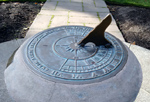 |
Victoria |
British Columbia |
Canada |
Horizontal Dial |
Dial 924 |
| A standard cast bronze sundial, 12 inches in diameter. It shows solar time with Roman numerals from V to VII with noon as XII. Also marked are the half and quarter hours. The hour lines and gnomon angle are correct for the latitude. The gnomon root is in the center of the circular casting in the center of the wind rose showing the cardinal directions. |
| |
| |
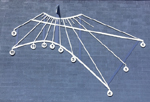 |
Lansing |
Michigan |
USA |
Vertical Dial |
Dial 923 |
| This is a vertical, east-declining sundial, 22 ft 6 in by 15 ft 10 in. The dial is constructed of 6061 aluminum alloy pieces electrostatically painted and bolted together,then mounted on a concrete block wall. The position of the gnomon, hour, solstice, and equinoctial lines are corrected for longitude to show time zone solar time. Stenciled hour line numbers are changed to display DST or EST at appropriate times of the year. Visitors can determine the correct time by referring to an Equation of Time display. During the year, the triangular gnomon tip casts its shadow on the declination lines of summer and winter solstices and equinoxes. This is the largest known vertical sundial in Michigan, and one of the largest in the United States. |
| |
| |
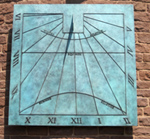 |
Middletown |
Connecticut |
USA |
Vertical Dial |
Dial 922 |
| This 6 x 6 ft. bronze, vertical sundial faces directly south on the curved sandstone wall of the Observatory. This dial was fabricated of Muntz metal bronze that received a hot applied green patina to compliment the brown sandstone color of this 1916 university observatory. Because of its large size, the metal dial weighs 650 lb. The hour numbers and lines are raised and applied to the surface of the dial. The Roman hour numbers that surround the dial plate in a frame take their shape according to the hour angle. Declination lines of the solstices and equinox are marked by the triangular gnomon shadow tip. The dial includes a built in longitude correction to show solar time for the time zone meridian. On a nearby wall below the dial, a plaque features an analemmatic graph for the equation of time correction to get clock civil time. |
| |
| |
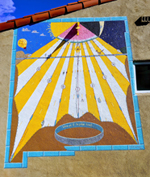 |
Albuquerque |
New Mexico |
USA |
Vertical Dial |
Dial 921 |
| This painted vertical dial is 10 x 11 feet, covering a vast expanse of south facing wall. The dial has a strong New Mexico theme using bright colors, and many personal elements. There is a road runner, hot air balloon, a lunar footprint (centered at 2:18 (clock time) on July 20th 1969, the minute they landed). There is a red, white & blue star at the 11th hour of the 11th day of the 11th month for Veterans Day. In the night exposure of the sundial the star Polaris is just above the gnomon, as it should always be. All the little embedded details in the sundial are explained on the ‘Details’ tab of the website link below. |
| |
| |
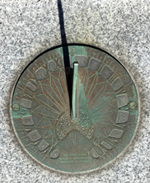 |
Vancouver |
British Columbia |
Canada |
Horizontal Dial |
Dial 920 |
| This is a 25 cm horizontal dial engraved on a 1/4 inch yellow metal plate (probably bronze). It shows local solar time. The hour marks look precise and consistent, but upon closer look are oddly arranged. The dialist attempted to shift the dial hour lines to correct for longitude (3.17 deg west). The AM hour lines are fairly accurate except the earliest hour lines (IV, V) which inconsistently meet the gnomon foot on the wrong side. The PM hour lines seem to mirror the AM lines except that 3 degrees had been added to each, rendering inaccurate time throughout the afternoon. The gnomon is slightly bent, and nearby buildings and trees block the dial at some times of day. The dial is decorated using simple geometric and visually pleasing patterns. Shallow engraving is used for the hour lines (making them a bit difficult to read), labels, and decoration. The gnomon has a bird engraved on each side and sits on a wedge base. The dial sits on a short granite pedestal with a polished top surface, and was commissioned by his parents in memory of Robert Carlyle Howard (born 1953, died 1970). |
| |
| |
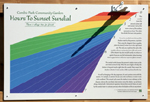 |
Vancouver |
British Columbia |
Canada |
Hours to Sunset |
Dial 919 |
| This bright and colorful vertical dial declines west, showing "Hours to Sunset" (Italian hours). The dial is decorated in the colors of the rainbow, with a band of color for each hour left to sunset. Quarter hours are marked using thin white lines. The dial was commercially printed on 60 x 90 cm (24 x 36 inches) sheet of aluminum-plastic laminated material with a UV-protective coating. In the summer of 2023, the previous gnomon was replaced with a 3D-printed carrot, the tip of which acts as a nodus. The supporting structure is made from red cedar. |
| |
| |
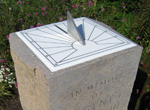 |
St. Louis |
Missouri |
USA |
Horizontal Dial |
Dial 918 |
| The dial plate is a 16 x 16 inch square piece of milk glass, with the hour lines and Arabic numerals made by sandblasting through a photo-etched stencil and then spraying black with lithichrome paint into the etchings. The triangular gnomon is made of 3/8 inch thick stainless steel. Saint Louis sculptor Abraham Mohler made the pedestal from EW Gold limestone quarried near Ste. Genevieve, MO. It is 18 x 18 inches square and 40 inches tall. |
| |
| |
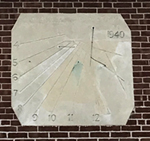 |
Attleboro |
Massachusetts |
USA |
Vertical Dial |
Dial 917 |
| A 45 x 45 inch slate sundial hangs over the bay window. The dial is a vertical decliner with hour lines from 4am to 1pm. The gnomon has been damaged, but if you look carefully, there is a nodus and on the dial face are faint declination lines showing summer & winter solstices and the equinox. The hours are delineated on the hour and marked in Arabic numbers. |
| |
| |
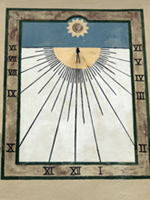 |
Perryville |
Missouri |
USA |
Vertical Dial |
Dial 916 |
| The sundial is attributed to Vincentian Brother Angelo Oliva, being painted sometime in the 14 year period between 1823, when he arrived in Perryville to lead the reconstruction of the original, wooden church into the present one made of stone, and 1837 when he died. The dial has been recently repainted. |
| |
| |
 |
Bellingham |
Washington |
USA |
Vertical Dial |
Dial 915 |
| The vertical dial is incorporated into a bright, flowing mural 29 x 54 feet covering nearly all of the south wall of a brick building. The mural was several years in the making. It began with an international competition sponsored by Allied Arts of Bellingham and sundial enthusiast Sasch Stephens. Ultimately the mural with embedded vertical dial was dedicated on the fall equinox. Called the "First Shadow Celebration" many local celebrities recognized the new mural artwork and old art of sun dialing. |
| |
| |
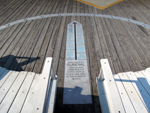 |
Wildwood |
New Jersey |
USA |
Analemmatic Dial |
Dial 914 |
| On the boardwalk, inset into the wood planks is a smooth concrete walkway about 12 inches wide. Months and instructions are given in neat lettering made in the concrete. The hours are done on a half-ellipse using the same smooth concrete, Arabic numbers, and 15-minute time marks (far narrower than a person's shadow). The dial is set for daylight saving time (with no longitude correction). |
| |
| |
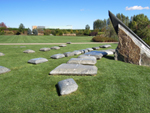 |
State College |
Pennsylvania |
USA |
Horizontal Dial |
Dial 913 |
| The Dr. Joel N. Myers Sundial monumental sundial is truly a masterpiece in time. The 11 foot tall black granite gnomon seems to grow out of a larger granite block. Time is marked by the several rows of low, large flat stones, 25 in all. They are set for summer solstice (first row), equinox (second row that has the stones all in a liner), and winter solstice (only for 10am-2pm. The stones themselves are too large for precise time telling, but the use of colored dots painted on the stones allows you to tell exact civil time using the tip of the sundial's shadow on the solstices and equinox. |
| |
| |
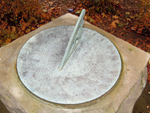 |
Greenville |
Pennsylvania |
USA |
Horizontal Dial |
Dial 912 |
| This bronze dial is about 14 inches in diameter with a coarse near-white patina. Time is delineated in 5 minute intervals from 4:30am to 5:30pm. The hours are marked in Roman numerals and includes a gnomon gap for a fairly thick gnomon. The dial sits on on square stone pillar and thick plinth. Measurement of the gnomon angle agrees with with latitude engraved on the dial plate of 40° 25' that is more than a degree off the latitude of the the dial site. |
| |
| |
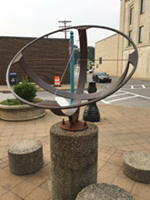 |
Carnegie |
Pennsylvania |
USA |
Equatorial Dial |
Dial 911 |
| Anthony Vitale, a life-long steel worker and internationally know metal sculptor, designed a dial for the place he once worked: Carnegie Steel. He started with a flat length of steel 72 inches long, selected the distance between hour lines to be 6 inches, delineated in 15 minute intervals. The result was an equatorial half-ring 45.836 inches in diameter. He added 3 1/4 inches buffer on each side of the equatorial, creating an outer ring 52 inches in diameter. Along the meridian half-ring, the sun's declination is marked with months when a nodus cross bar casts a horizontal shadow at solar noon. The concrete base can unfortunately be rotated and it seems to point to the magnetic north, but bringing a compass or modern cell phone near the steel armillary instantly creates a distortion. |
| |
| |
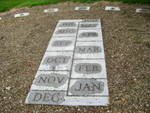 |
Sewickley |
Pennsylvania |
USA |
Analemmatic Dial |
Dial 910 |
| Sewickley is a borough in Allegheny County, Pennsylvania, 12 miles (19 km) west northwest of Pittsburgh along the Ohio River. Riverpark was created in 2010 with a meandering path. At one stop is a plain analemmatic sundial approximately 15 feet across on a gravel bed. Hour markers are granite stones showing 4am-8pm. The analemmatic walkway has engraved abbreviations of the months, looking like granite blocks, but actually clever and beautiful concrete. |
| |
| |
 |
Pittsburgh |
Pennsylvania |
USA |
Sculpture/Artwork |
Dial 909 |
| The memorial is positioned and shaped to capture sunlight through its vertical spaces. While the sun travels the horizon, columns of light shine onto the ground, highlighting words engraved in the stone below that express individual and shared experiences about the war. |
| |
| |
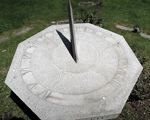 |
Pittsburgh |
Pennsylvania |
USA |
Horizontal Dial |
Dial 908 |
| This granite memorial octagonal sundial is approximately 5 feet across. The top is unadorned, containing only the delineated hour lines in 15 minute intervals and hour marks in Roman numerals from 5am-7pm. The gnomon has a sharp style |
| |
| |
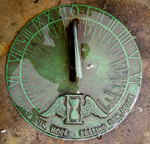 |
Chatham Village |
Pennsylvania |
USA |
Horizontal Dial |
Dial 907 |
| This bronze dial is about 12 inches in diameter. The outside chapter ring is delineated in 15 minute intervals with hours shown in Roman numerals from 4am-8pm. The gnomon has the profile of a bird under the style. Unfortunately the photos show that the gnomon has been installed backward on the dial. At the south end of the sundial is the classic hour glass and wings, symbolizing "Time Flies". |
| |
| |
 |
Meadville |
Pennsylvania |
USA |
Horizontal Dial |
Dial 906 |
| This patina dial shows lots of wear. Although it sits on an elegant helical pedestal. The dial has a compass rose and from measurements of both the dial and gnomon, it was constructed for London at 51 degrees. This is further supported by the hour extent from 4am to 8pm. The hours are delineated in irregular 5 minute marks with hours shown as Roman numerals. The 6am to 6pm hour lines should be exactly opposite, but are angled toward the gnomon foot. Unfortunately this dial never kept good time in London and certainly can not tell accurate time in Pennsylvania. |
| |
| |
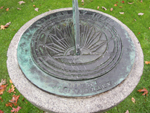 |
Meadville |
Pennsylvania |
USA |
Horizontal Dial |
Dial 905 |
| The sun dial was given to the college in 1909 by the Class of '99 as a memorial on their tenth anniversary. It consists of an elegant bronze dial showing time from 6am-6pm delineated in 15 minute increments. Hours are shown in Roman numerals. The gnomon has the number "99" beneath the style. The dial is mounted on a granite pedestal forty inches in height. |
| |
| |
 |
Fairport |
NY |
US |
Analemmatic Dial |
Dial 904 |
| This analemmatic sundial was created in 2017, 200 years after construction on the Erie Canal began. Artist Vanessa Sheldon "created the sundial [hour marks] using salvaged canal stones [from Erie Canal Lock 58]." According to WHAM News the sundial was unveiled by the Fairport Industrial Development Agency and Fairport Public Art Committee. Funding for the project was partially paid for by a $50,000 matching grant through the Finger Lakes Regional Economic Development Council. |
| |
| |
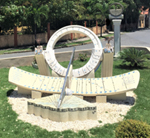 |
Los Rios Santo Domingo |
Distrito Nacional |
Dominican Republic |
Compound Dial |
Dial 903 |
| This highly decorated monument sundial is composed of three sundials (Horizontal, Polar and Equatorial) with a common gnomon. All of the dials are built mainly of limestone. The large polar dial (wings), small horizontal dial (tail) and gnomon (body) recreate a “hummingbird”, the universal symbol for diabetes. (The hospital specializing in diabetes is only 500m away). The dials are delineated in half hours and have a variety of graphics on all three dials. In the same location, albeit separated there is another equatorial clock that is five times smaller and has a custom gnomon in the shape of the "little hummingbird”; this sundial is mounted on top of a column and has been adjusted to the local solar time. Nearby is a plaque with the equation of time. |
| |
| |
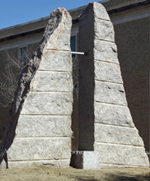 |
Sherman |
Texas |
USA |
Noon Mark or Meridian Dial |
Dial 902 |
| Outside the library are two stone granite guardians about 12 feet tall. They create a noon marker along a low stone wall set along the solar meridian. There are three markers rods set horizontally across the top of the wall that catch the shadow of a horizontal bar set between the two granite pillars. The shadow falls on the farthest horizontal rod on the wall at winter solstice. During the summer solstice, the shadow falls on the nearest rod to the granite block. And on the spring and fall equinox, the shadow falls on the middle rod. |
| |
| |
 |
Pelham Manor |
New York |
US |
Vertical Dial |
Dial 901 |
| This south facing vertical dial is 4x2 feet made of concrete, now slightly brown with age. The graceful gnomon is white-painted metal. Hour numbers in Roman numerals extend from 6am to 6pm without further delineation. |
| |
| |
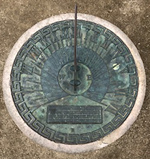 |
Palo Alto |
California |
USA |
Horizontal Dial |
Dial 900 |
| This horizontal bronze dial is 14.5 inches in diameter, mounted on a fluted pedestal. The gnomon angle is set for the latitude and is 5 5/8 inches tall. Graceful hour lines extend from 5am to 7pm marked by Roman numerals. It is delineated only with half-hour lines. Surrounding the dial face is a zig-zag decoration. |
| |
| |
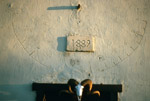 |
Santa Cruz Island |
California |
USA |
Vertical Dial |
Dial 899 |
| This vertical dial has undergone a number of restorations since it was set in lime in 1889. A photograph from 1900 shows the placement of a gnomon rod is horizontal. In 1992 before the National Park Service restoration in 2012 the gnomon is set in a polar orientation. But it doesn't really matter since the hour lines are marked at nearly regular 15 degree intervals with half hour sub-marks. |
| |
| |
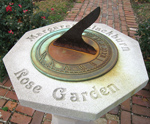 |
Webster Groves |
Missouri |
USA |
Horizontal Dial |
Dial 898 |
| This horizontal sundial is mounted on a hexagonal graceful concrete pedestal 43 inches high. The top of the pedestal is slightly sloping hexagonal 17 inches on a side. The circular bronze dial at the center is 11 inches in diameter. The hour lines meet a chapter ring with time marked in 15 minute intervals. Roman numerals mark the hours from 6am to 6pm. The 5 1/2 inch gnomon is of badly rusted steel, with iron stains covering the central part of the dial face. The sundial was vandalized at some time in the past and the original gnomon stolen. |
| |
| |
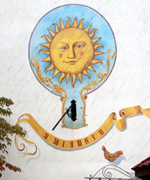 |
Frankenmuth |
Michigan |
USA |
Vertical Dial |
Dial 897 |
| The dial is elegantly painted on the south wall declining 30 deg west. Dial shows daylight savings time using dark red Roman numerals on a golden ribbon banner. The gnomon is a simple rod held firmly to the wall by an ornate bracket. Above the dial is a large smiling sun surrounded by a sky blue band. |
| |
| |
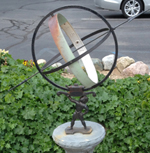 |
Frankenmuth |
Michigan |
USA |
Armillary Sphere |
Dial 896 |
| This is a mass produced armillary dial held at the latitude of Frankenmuth by the statute of a boy with raised arm. All this sits on a pedestal with a Greek motif. The meridian circle made of iron is about 2 feet in diameter. The equatorial band is about 3 inches wide with some corrosion present. Inside the equatorial there appears to be an aluminum interior band of Arabic numbers riveted to the equatorial. Hours and half hours are marked by dot bumps in the aluminum. There is an iron latitude ring for decoration. The bronze gnomon extends the meridian circle with both an arrow point and feathered tail. |
| |